![[Previous]](prev.gif) |
![[Contents]](contents.gif) |
![[Index]](keyword_index.gif) |
![[Next]](next.gif) |
![[Previous]](prev.gif) |
![[Contents]](contents.gif) |
![[Index]](keyword_index.gif) |
![[Next]](next.gif) |
In this chapter:
The C/C++ perspective is where you develop and build your projects. As indicated in the IDE Concepts chapter, a project is a container for organizing and storing your files.
Besides writing code and building your projects, you may also debug and analyze your programs from the C/C++ perspective.
 |
You'll find complete documentation on the C/C++ perspective, including several tutorials to help you get started, in the core Eclipse platform documentation set (.) |
The views in the C/C++ perspective are driven primarily by selections you make in the C/C++ editor and the C/C++ Project Explorer view. The Project Explorer view is configured specifically for C and C++ development.
For more information about the Navigator view, see the Workbench User Guide:
| For information about the Navigator view: | See these sections in the Workbench User Guide: |
|---|---|
| Toolbar and icons | |
| Right-click context menu |
To create and run your first program, you'll use two major facilities within the IDE:
After you've used these features of the IDE for the first time, you'll be able to create, build, and run your programs very quickly. For details about wizards and launch configurations, see the Common Wizards Reference and Launch Configurations Reference chapters in this guide.
The Project Explorer view in the C/C++ perspective is perhaps the most important view in the IDE because you can use it to control your projects. The selections you make in the Project Explorer view greatly affect what information the other views show.
The Project Explorer view gives a “virtual” or filtered presentation of all the executables, source, and shared objects that comprise your project. You can set filters for the types of files you want shown in this view. For information about how to set filters, see “Filtering files.”
The Project Explorer view has many of the same features as the Navigator view, but it is configured specifically for C and C++ development. At first glance, the two views may seem identical, but the Project Explorer view:
The project opens — you can see it in the C/C++ Project Explorer view.
To hide certain files from the Project Explorer view:
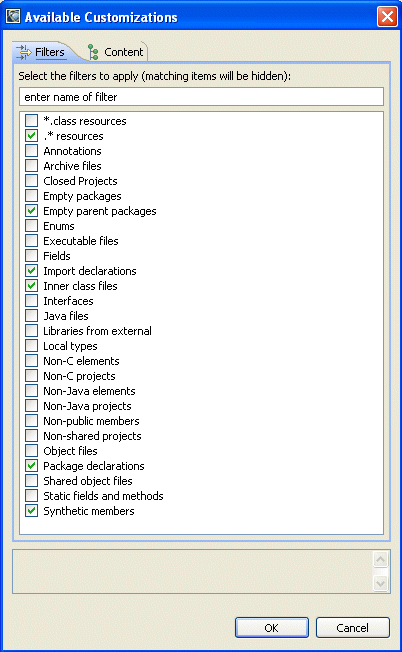
The Project Explorer view shows you an outline of the C/C++ source and header files in a project:
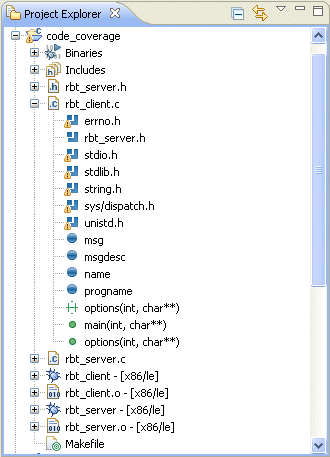
Project Explorer view: outline source and header files for a project.
You can also use the Outline view to see the structure of your projects. (For more information about the Outline view, see the “Code synopsis” section in this chapter.)
The Project view shows you the outlines of binary files as well. You can examine the structure of executables or object files to see the elements that you defined or used in the file, as well as implicitly used elements, such as malloc(), _init(), and errno:
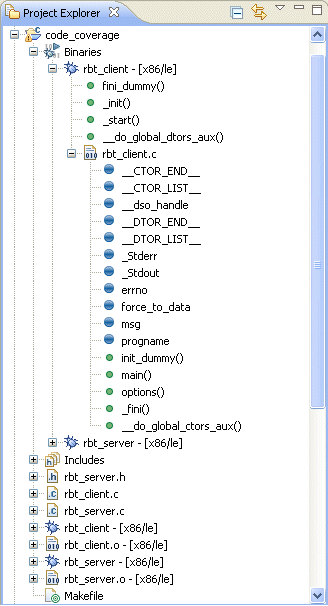
Project Explorer view: outline source and executable for a project.
To fully understand the use of projects in the IDE (how to set up projects, what types of projects to choose, and how to organize projects to perform effective builds from IDE, and command line), you need to be aware of the following:
The QNX Momentics IDE is based on the open source Eclipse platform and the open source CDT project, which provide the essential portion of the functionality for projects and builds. The IDE uses the concept of a workspace that is a user-specific, writable directory on the local host. Note that this directory itself should never be included as part of a revision control system shared between users, nor should it be located on a shared drive (unless you're certain there will only ever be one user that uses it).
The IDE uses the concept of a project, which is a container for source and binaries, together with some configuration files that is usually located in the workspace. This project can be shared between users using a version control system. Projects themselves are flat; they cannot contain one another. However, there is a concept of a working set that lets you filter and group projects if you have too many of them in a workspace. There is also special QNX Container project which allows you to control/build sets of projects at the same time.
 |
When you select a location for your workspace, as well as the names for your projects, be aware that these names can be used in the build; make doesn't like directory and file names that contain spaces and non-standard characters. The IDE might accept these characters; however, the build wouldn't work with such these names. |
A project isn't a virtual container that contains arbitrary files and directories. You need to have a directory in the file system that contains the project root (source and build output), and use the same directory to contain the project metadata. If you want to separate project metadata from the source directories, you'll have to use folder links. You have an option to include the project inside your workspace, or outside the workspace. You can determine how to create the project directory; you can check out the top level from one location and subdirectories from another location, and you can also use OS soft links, or some other means to create it.
The QNX IDE supports these project types:
A Makefile project would work for any project that has a Makefile (by default). A Makefile project can launch anything as an external builder in any folder. The IDE starts make, and after make exits, the IDE refreshes the workspace to see what was created. You can change the make command and/or run specific make targets, but IDE has no control over what make is doing.
Since the IDE doesn't know what's being built, it would have problems parsing source files (which it does internally to allow navigation, code completion, syntax highlighting, code generation, and refactoring). Therefore, if you use a Makefile project, you have to modify the Indexer (the internal parser) to point it to the missing Includes, as well as what Defines your parser uses for conditional compilation. The process of determining this is called Discovery, and it can be controlled using Discovery Options.
 |
If you know what includes and defines you want to use, it's easier to specify them directly (). |
A QNX project is a special kind of Makefile project with additional control over the make. To use a QNX project, you also have to use QNX recursive Makefiles. QNX recursive Makefiles are conventions for creating Makefiles that use specific variables and layout. This lets the IDE parse the Makefile, and to provide the GUI with control over the Makefile options and build variants. typically, a single QNX project is good enough to build one binary/library for several variants, such as x86 and PPC in the debug, release, and profiling modes.
A managed project is CDT-specific project that doesn't use Makefiles, and all of the build settings are controlled by the GUI. The problem associated with this project type is its inability to perform a build of the project from command line (although, it is possible in simple cases with some additional setup files, or you can use a Makefile generator). In addition, there are restrictions on what you build and how, particularly if you use special steps in the build that involves other tools.
Lets consider scenarios that can occur when you are creating a project for the first time (compared to checking out an existing project, see “Checking out existing projects.)” When creating a new IDE project, you have to determine what you'd like to do:
To create a project for the first time:
If you want to perform a partial checkout of the source, see “Checking out a partial source tree.”
In this example, we'll use SVN and describe the procedure to create a project by checking out the source from several folder locations in your version control system. For example, you have a folder in SVN called my_big_project, and this folder contains 100 subfolders (where each of them represent a different binary). If the my_big_project folder has a Makefile and some other common folders, such as public_includes that you need in order to compile your subfolder my_binary, you'd have to follow these steps:
 |
If you checked out more than one project that shares an SVN folder as its project root, you can't commit the .project file back into SVN. You would need to add it to the SVN ignorefile to prevent it from showing up as a changed resource. |
Now, when you create a project, you may want to share the settings so that the next person can easily check it out as a project. If given project root matches with exactly one folder in source control system, you may commit the project metadata files back into source control (.project and .cproject). If your project is attached to version control but you don't want it to be committed, you have to add those files into “ignore” list.
QNX projects share most of their options in Makefiles itself, however, some options (such as the current build variants) are user-specific (i.e. not in the project metadata). You can make them shared by enabling Share project properties on the Main tab for the QNX project properties.
The IDE integration with source control (CVS and SVN) can detect the presence of the project metadata in the repository, or checkout existing projects. You have an option to search recursively and checkout all existing projects from a selected folder, or choose a specific project. You can also create a special file, called Team Project Set (.psf), which contains a set of projects that you want everyone to check out. Team sets can be located in the source control repository, and the IDE will recognize them (and should be able to check out all specified projects automatically).
If you don't want to build using the IDE, but you want to use the debugger, the System Profiler, or if you want to find memory corruption, you can create a simple project in IDE to use by any of these tools. To configure this type of project, follow these steps:
If you want the source navigation and sources aren't in the same location where they were compiled, you need to enable Source Path Lookup (edit the Source tab for the launch configuration to provide a lookup).
For more details, see in “Example #4” below.
In the IDE, you can set build properties for the following types of projects:
You can modify the build properties for a QNX project using Project Properties (right-click on a project in the Project Explorer view and select Properties), or by modifying the Makefile. If you manually modify a Makefile, you might make it unrecognizable by the IDE and it won't be able to properly update in the future.
Some of the Project Properties that you can set for a QNX project are:
You can modify the build properties for managed projects using Project Properties (right-click on a project in the Project Explorer view and select Properties). Some of the Project Properties that you can set for a managed project are:
To exclude a file from a build, select a file, right-click and then select Exclude from build. To include a folder into the build, it has to be a source folder, or you click on a folder, select Properties, and then deselect the Exclude from build option on the C/C++ Build page. You can use Internal Build or External Make build with the make generation (select ).
For a Makefile project, you can change the location where the build starts from, and the make arguments (as well as the command to launch make itself). In addition, you can change the environment variables for the make invocation in the environment subcategory of the C/C++ Build options. If you're using QNX naming conventions for make variables, the same variable can be changed automatically from the Settings tab. If they are defined in make itself, environment variables can't override them unless you use make -e. For all of the other options, you set them in your Makefile.
To perform a simple build for an active configuration, select one or more projects, right-click and then select Build Project. To clean project(s) before you build, right-click on a project and then select Clean Project.
For QNX and Makefile projects, you can create and build specific make targets using the context menu for the selected project.
For a managed project, you can change the active default configuration and build using the Build Configurations menu. When you perform a build for managed project, you can also set a global preference to build a single configuration, or all of them at once.
A container project is a specific complex quasi-hierarchical project that lets you combine a set of projects in order to quickly switch between different build configurations. The root of the container project is always a container, and the container's children are configurations. A configuration is a set of projects of various types (including other containers). Each member of the configuration has two important attributes specific for the container environment: the target and the variant. These are very generic attributes, and their interpretation is completely defined by a particular configuration member. For example, for a QNX C project, the target is a build target (such as build, clean, and variant, which for an x86 platform, can be something like x86/release, x86/debug). To build any desirable configuration, select a container configuration from the dropdown menu. For a managed project, you can use working sets to build them together.
To build one or more projects in the IDE workspace from the command line, use the following command:
mkbuild -ws <workspace> [options] mkbuild [-project] <full_project_path> [options] mkbuild -ws <workspace> -projects <project1,project2> [options]
Where:
 |
No spaces are allowed for project names, as well as in the list of projects or targets. |
If a project doesn't support a target, the default target would be built. By default, for make projects, no targets are defined; make targets have to be created from the UI in order to use named targets.
To build a default target and variant for the project projectA:
mkbuild /home/user/workspace/projectA
To build all projects in a specified workspace:
mkbuild -ws /home/user/workspace
To build using another IDE installation:
>QDE=/home/user/IDE4.6 mkbuild ...
To build the projectA and projectB projects with clean, all targets, and the x86 variant/configuration:
mkbuild -ws /home/user/workspace -projects projectA,projectB -target clean,all -variant x86
To configure an automated build, you have to use make. If you're using a managed project, you have to use Gnu Make Build, which generates the Makefiles for you. If the projects don't have any dependencies, you only have to run make in a root directory (or other appropriate directory). If you want to build several projects, you have to create an external Makefile that references all subprojects.
For example, if your local C++ source files have the following structure:
-source
-a
+inc
-b
-mydir
+src
+out
Makefile
If you work in a directory called mydir, you can run make. Running the make command will collect the libraries from the other parts of the filesystem, and obtain the includes (including the local ones from the mydir directory).
To create a project:
this is a required step for the internal parser(for code navigation, refactoring, syntax highlighting, and so on).
If the Makefile isn't in the root (the Makefile is in the out directory), and this is the build directory, configure the build using the following steps:
If the Makefile is in the root (the Makefile is in the out directory), and this is the build directory, configure the build using the following steps (it's the same steps as Example 1, but your out directory is outside of mydir):
If the source code is in directory A, the output binaries are in directory B, and the extra includes are in directory C, all of the directories have a common root, D (i.e. D/x/y/z/A, D/x/C, and D/w/C).
If you want a project by itself, with it's metadata located in another location (and you also want to share it if possible), do the following:
You should see a path something like ROOT_DIR/x/y/z/A in the path.
Now if the make file is in folder A (source folder), you'll need to instruct the IDE to run make from that location.
Now, the Build Project and Clean Project will work; you'll see your binaries in Binary container, and your includes in Includes container. Open a source file and verify that the Include navigation works (double-click on the external include in Outline view to navigate to that location).
 |
In earlier versions of the IDE, there were two different project types: Managed make, which automatically generated a Makefile, and Standard make, which required a Makefile in order to be built. Now, you select a project type, and that determines the build system to use.
You can continue to create a make project using the C or C++ wizard. For instructions about how to create this type of project, see “Creating the equivalent of a make project.” |
If you're creating an application from scratch, you'll probably want to create a QNX C Project or QNX C++ Project, which relies on the QNX recursive Makefile hierarchy to support multiple CPU targets. For more information about the QNX recursive Makefile hierarchy, see the Conventions for Recursive Makefiles and Directories chapter in the Neutrino Programmer's Guide.
 |
If you want to import an existing project, see “Importing existing source code into the IDE” in the Managing Source Code chapter in this guide. |
Use the New Project wizard whenever you want to create a new project in the IDE.
To create a simple “hello world” type of program:
![]()
(You can use the dropdown menu to create different types of C/C++ projects.)
The New Project wizard appears.
 |
There are actually several ways to open the New Project wizard. For details about the wizards, see the Common Wizards Reference chapter in this guide. |
 |
Although the wizard allows it, don't use any of the following characters in your project name:
| ! $ ( " ) & ` : ; \ ' * ? [ ] # ~ = % < > { } Using these characters in a project name will cause problems later. |
If you don't want to build both debug and release variants, expand the item for your target type and disable Debug or Release.
 |
If you have the Memory Analysis tool or Application Profiler tool (or both) selected for your configuration, you can set only one the debug or release variants when you create a project. For a managed project, to make a change to your existing variant(s), you'll need to select and then build again, or perform a clean before you make the change to the target variant(s). |
The IDE creates your new project in your workspace. Your new project is displayed in the Project Explorer view, and in the Navigator view. If a message box prompts you to change perspectives, click Yes.
For information about converting existing projects, see “Converting a QNX project to a managed make C/C++ project” and “Converting a regular project to a managed make C/C++ project.”
You can continue to create a typical make project using the C or C++ wizard:
The result is an empty make project, which is similar to the Set QNX Environment action in previous IDE releases.
 |
After you create your project, if you right-click on the project, select Properties and from the menu on the left expand , for the Runtime field on the General Settings tab, the Default setting refers to C++ Dinkum with exceptions. |
To create a Makefile that can be launched outside the IDE:
The IDE generates a number of .mk files, and a top-level Makefile for each processed configuration (the last one in the configuration folder). You can process this Makefile from command line using the make utility:
make -f [configuration]/makefile [target]
Managed make projects provide full IDE graphical control and configuration, and they take advantage of the Eclipse framework (i.e. the incremental compiles, links, and so on). For additional information, see “Understanding projects in the IDE” and “Setting build properties for a project.”
The C/C++ search features use an index of symbols (from the source code in your projects, and from external header files) to find the locations of declarations and references. By default, the indexer is set to Fast, which means that it provides fastest indexing capabilities (for declarations and cross reference information). This is the recommended indexer.
To specify an indexer type for a project, open the project's Properties dialog, and then select C/C++ Indexer from the list on the left.
To specify an indexer type as the default indexer for new projects, choose , expand C/C++ in the list on the left, and then choose Indexer.
In either case, you have the following choices:
In this section…
After you've created a project, you'll want to build it. Note that the IDE uses the same make utility and Makefiles that are used on the command line.
The IDE can build projects automatically (i.e. whenever you change your source), or let you build them manually. When you do manual builds, you can also decide on the scope of the build.
 |
When you right-click on a project and select Build Project, there is a particular scenario where the C/C++ perspective will ignore the Build Project command. For example, if you build a make project and then modify and build the project outside the IDE for a library that it needs to link against, when you attempt to select Build Project in the IDE, it won't reissue the make all for the project. The IDE ignores the explicit user-specified build request for this particular scenario. |
The IDE uses a number of terms to describe the scope of the build:
You can watch a build's progress and see output from the build command in the Console view. If a build generates any errors or warnings, you can see them in the Problems view.
By default, the IDE builds your project only when you tell it to, but it can also build your project automatically every time you change a file or other resource in any way (e.g. delete, copy, save, etc.). This feature is optimal when you have reasonably sized projects that are small in size, or not too many projects open at the same time. However, for best performance with very large projects, or if you have many open projects, you will want to leave the autobuild feature disabled.
To enable the autobuild feature:
The IDE builds your projects only when you change a file or other resource.
QNX C/C++ projects have their own autobuild setting. To set the autobuild feature for QNX C/C++ projects:
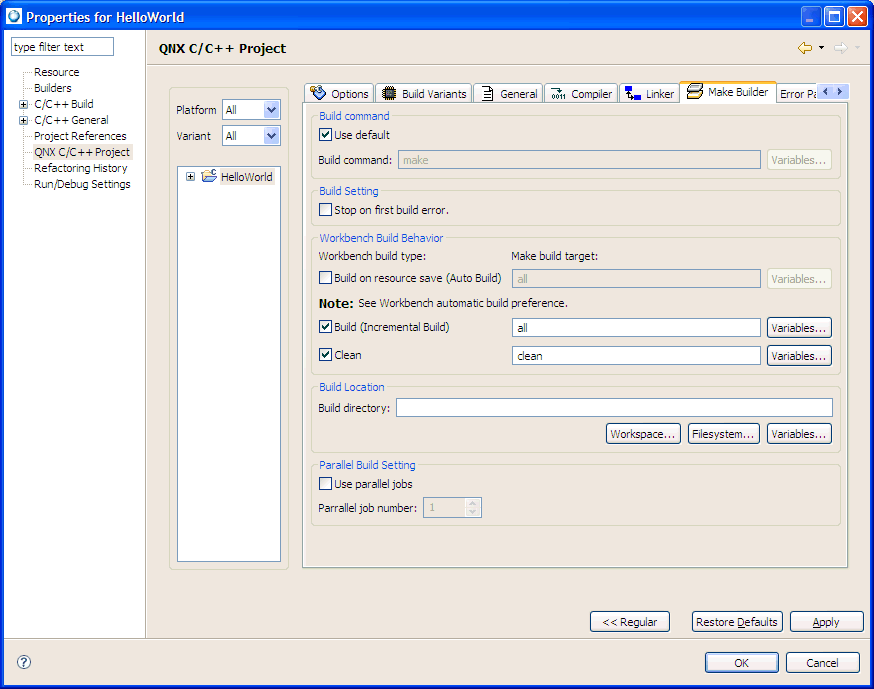
The IDE lets you manually choose to build all your open projects. Depending on the number of projects, the size of the projects, and the number of target platforms, this could take a significant amount of time.
To rebuild all projects, you should clean the projects first, and then run a build:
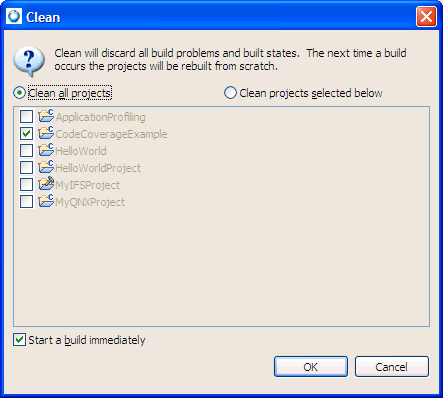
The IDE automatically saves all your changed resources before you do a manual build. To turn off this feature:
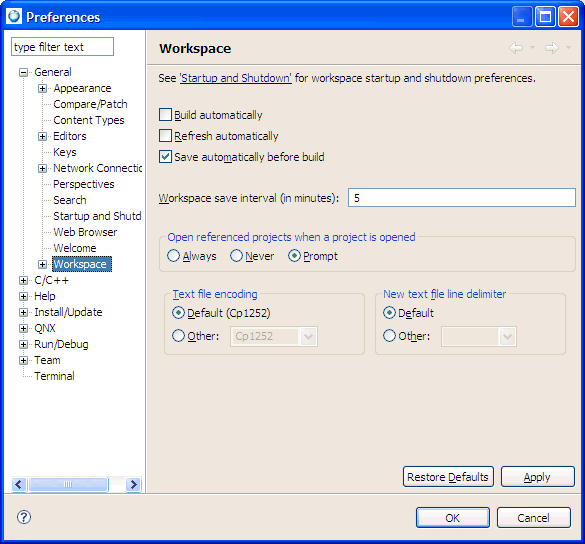
The IDE no longer saves your resources before it builds your project.
You can instruct the IDE to build certain projects before others. If a given project refers to another project, the IDE builds that project first.
 |
Setting the build order doesn't necessarily cause the IDE to rebuild all projects that depend on a given project. You must rebuild all projects to ensure that all dependencies are resolved. |
To manually configure the project build order:
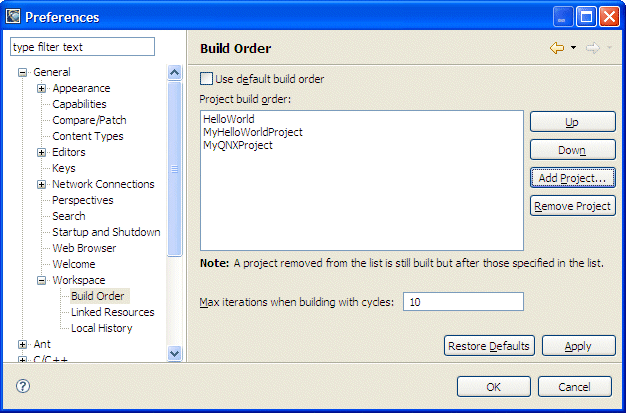
 |
In this section, the term “targets” refers to operations that the make command executes during a build, not to target machines. |
A make target is an action called by the make utility to perform a build-related task. For example, QNX Makefiles support a target named clean, which you invoke as make clean. The IDE lets you set up your own make targets (e.g. myMakeStuff). You can also use a make target to pass options such as CPULIST=x86, which causes the make utility to build only for x86. Of course, such an option would work only if it's already defined in the Makefile.
To add your own custom make target to the C/C++ Project Explorer view's right-click menu:
You'll see your target option listed in the Build Targets dialog, which appears when you select the Build Make Target… item from the right-click menu of the C/C++ Project Explorer view. Your targets also appear in the Make Targets view.
To build your project with a custom make target:
 |
To remove a make target:
|
Adding a helpful “use” message to your application lets people receive an instant online reminder for command-line arguments and basic usage simply by typing use app_name.
Usage messages are plain text files, typically named app_name.use, which are located in the root of your application's project directory. For example, if you had the nodetime project open, its usage message might be in nodetime.use. This convention lets the recursive Makefile system automatically find your usage message data.
For information about writing usage messages, see usemsg in the Utilities Reference.
To add a usage message to your application when using a QNX C/C++ Project:
If your usage message is in a file with a different name, or you want to explicitly specify your usage message's file name, change the USAGE line as follows:
USAGE=$(PROJECT_ROOT)/usage_message.use
where usage_message.use is the name of the file containing your usage message. This also assumes that your usage message file is in the root of the project directory. If the usage message file is located in another directory, include it instead of $(PROJECT_ROOT).
To add a usage message to your application when using a Standard C/C++ Project:
usemsg $@ usage_message.use
where usage_message.use is the name of the file containing your usage message.
 |
Before running an application, you must prepare your target. If it isn't already prepared, you must do so now. For information about configuring your target, see the Preparing Your Target chapter in this guide. |
After you build a project, you're ready to run it. The IDE lets you run or debug your executables on a remote QNX Neutrino target machine. (For a description of remote targets, see the IDE Concepts chapter.)
To run or debug your program, you must create both of the following:
 |
For a complete description of how to create a QNX Target
System Project, see the Common Wizards
Reference chapter in this guide.
For a complete description of the Launch Configurations dialog and its available options, see the Launch Configurations Reference chapter in this guide. |
To create a QNX Target System Project:
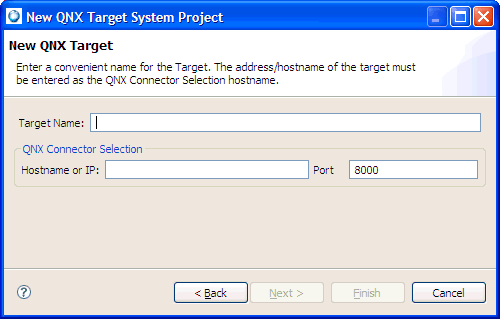
 |
When you update the Target properties from the Attributes pane, your changes won't be updated if you modify the Hostname or IP address, and then click Apply. You must click OK to confirm the changes and close the properties window for the changes to take effect. |
You'll see your new QNX Target System Project in the Navigator view.
To create a launch configuration so you can run your project:
 |
Make sure you build your project first before you create a launch configuration for it. See “Building projects” above. |
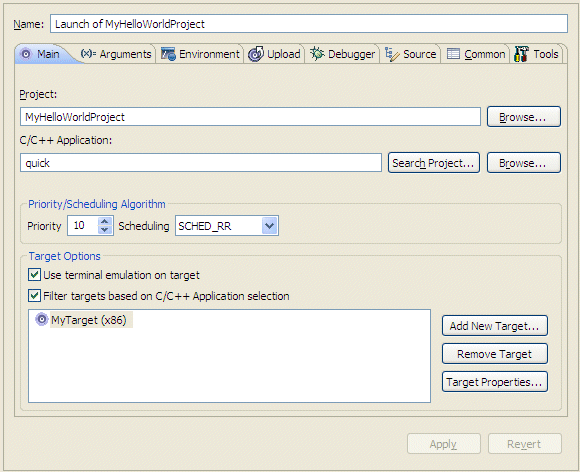
Your program runs, and the IDE shows its output (if any) in the Console view.
To delete a project:
 |
When you delete a project in the IDE, any launch
configurations for that project aren't deleted.
This feature lets you delete and recreate a project without
also having to repeat that operation for any corresponding
launch configurations you may have created.
For more on launch configurations, see the Launch Configurations Reference chapter in this guide. |
In this section…
The C/C++ editor is where you write and modify your code. As you work in the editor, the IDE dynamically updates many of the other views (even if you haven't saved your file).
The C/C++ editor has a gray border on each side. The marker bar might contain icons that indicate errors or other problems detected by the IDE, as well as icons for any bookmarks, breakpoints, or tasks (from the Tasks view). The icons in the left margin correspond to the line of code.
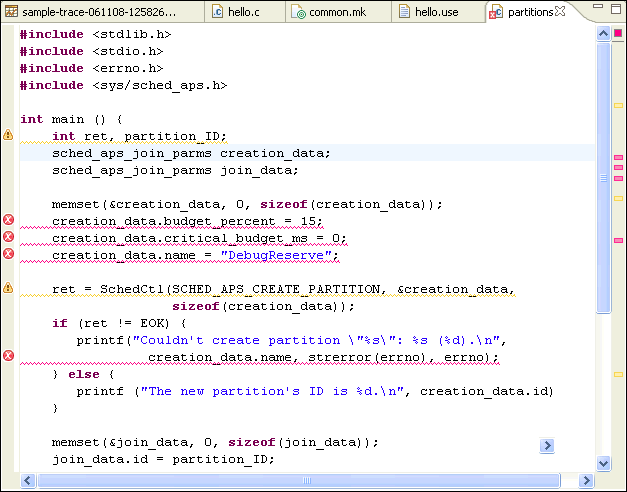
The C/C++ editor.
The border on the right margin shows red and yellow bars that correspond to the errors and warnings from the Problems view. Unlike the left margin, the right margin shows the icons for the entire length of the file.
The Content Assist feature can help you finish the names of functions if they're long or if you can't remember the exact spelling.
To use Content Assist:

The IDE includes another code-completion feature that can insert a template for predefined code structures, such as an empty do-while structure. If you've already used the Content Assist feature, you may have already noticed the code templates feature; you access it the same way.
To use code templates:

The IDE lets you enable as many of these templates as you require, edit them as you see fit, create your own templates, and so on.
To edit a template or add one of your own:
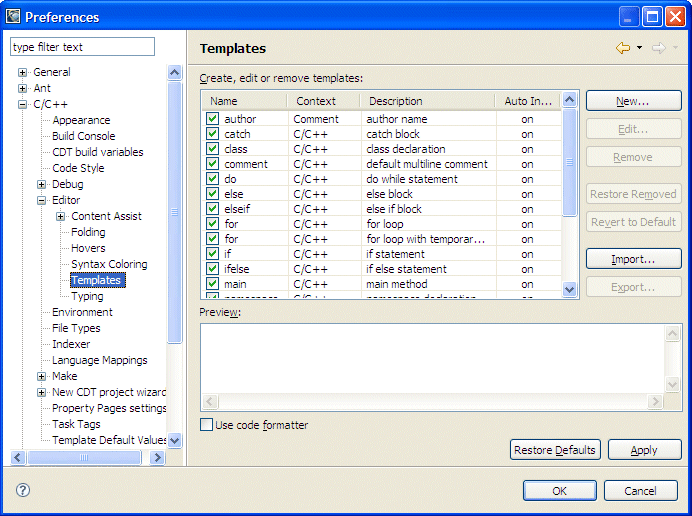
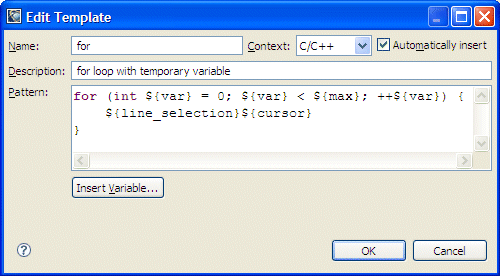
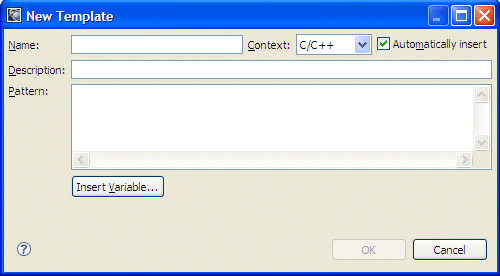
To insert the appropriate #include directive for any documented QNX Neutrino function:
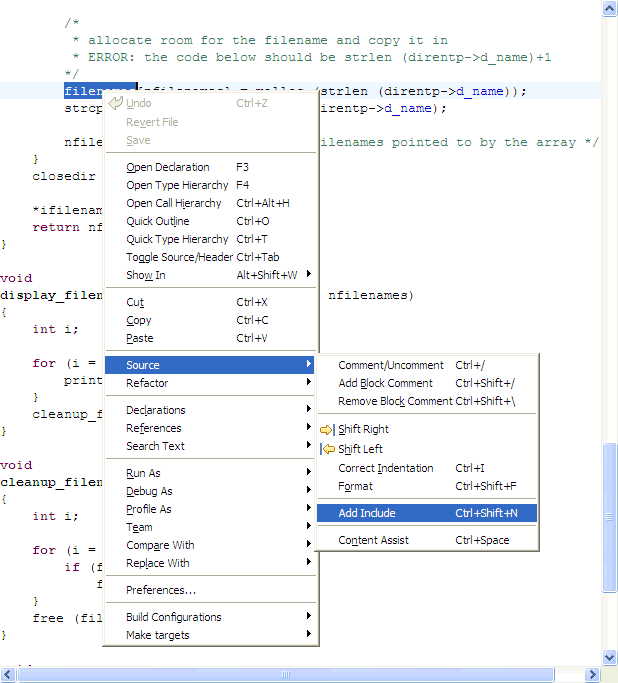
The IDE's hover help feature gives you the synopsis for a function while you're coding.
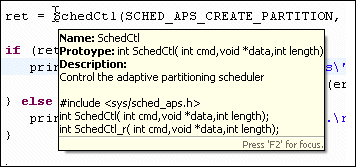
Hover help in the C/C++ editor.
You can easily add comments using either the C or C++ style, even to large sections of code. You can add two forward slash characters (//) at the beginning of lines to comment out large sections, even when they have other comment characters, such as /* */.
When you remove comments from lines, the editor removes the leading // characters from all lines that have them, so be careful not to accidentally uncomment sections. Also, the editor can comment or remove comments from selected lines — if you highlight a partial line, the editor comments out the entire line, not just the highlighted section.
To comment or remove comments from a block of code:
In the C/C++ editor, you can:
You can do all this using C/C++ Editor or Text Editors preference dialogs:
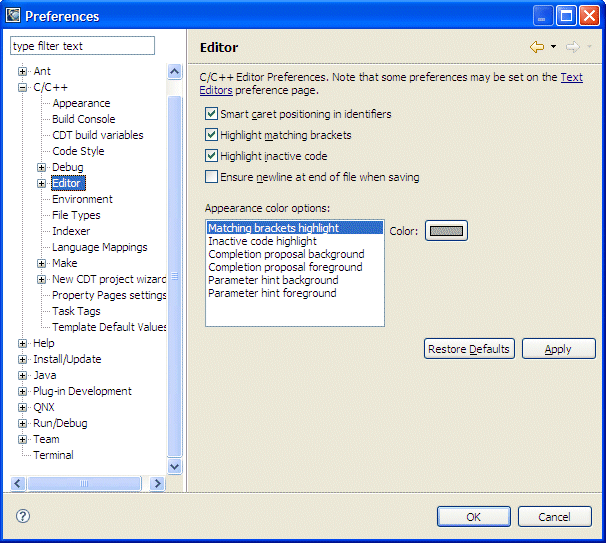
C/C++ editor: Preferences.
To change fonts, background color, or to show line numbers:
To change syntax highlighting, convert tabs into spaces, and change the folding options, open the C/C++ editor preferences dialog:
To set Content Assist options, open the Content Assist preferences dialog:
You can use a different text editor than the one that's included with the IDE, but you'll lose the integration of the various views and perspectives. For example, within the C/C++ editor, you can set breakpoints and then see them in the Breakpoints view, or put “to-do” markers on particular lines and see them in the Tasks view, or obtain hover help as you pause your cursor over a function name in your code, and so on.
If you want to use other editors, you can do so either externally, or within the IDE.
You can edit your code with an editor started externally from the IDE (e.g. from the command line). When you're done editing, you'll have to synchronize the IDE with the changes.
You can specify file associations that determine the editor you want to use for each file type. For example, you can instruct the IDE to use an external program such as WordPad to edit all .h files. After you set that preference, you can double-click a file in the Project Explorer view, and the IDE automatically opens the file in your selected program.
If you have multiple associations for the same file extension, the IDE always opens the same editor, which is marked as the default in the list of editors for this extension, but other associations continue to be available. To open a file in an alternative editor, right-click on the file you want to open, select , and then choose the editor. This change means that you are also changing the default editor for this extension.
If the IDE doesn't have an association set for a certain file type, it uses the host OS defaults. For example, on a Windows host, if you double-click a .doc file, Word or WordPad is automatically launched and opens the file.
 |
For more information about file associations, follow these links in the Eclipse Workbench User Guide: . |
By default, the IDE creates a simple “hello world” C/C++ source file for you, which you may or may not want to use as a template for your own code.
To create a new C/C++ file:
![]()
You'll see an empty text editor window, ready for you to begin working on your new file. Your filename appears highlighted in blue in the title bar above the editor.
In this section…
Besides the features already described above, the IDE has several other helpful facilities worth exploring.
The Problems view provides you with a list of errors and warnings related to your projects. These are typically syntax errors, typos, and other programming errors identified by the compiler:

The Problems view.
The IDE also shows corresponding markers in several other locations:
Depending on the complexity and stage of your program, the IDE can generate an overwhelming number of errors. But you can customize the Problems view so you'll see only the errors you want to see.
The Filters dialog lets you adjust the scope of the errors shown in the Problems view. The more options you select, the more errors and warnings the IDE displays in the Problems view.

The Filters dialog, where you can select what errors are displayed in the Problems view.
The Tasks view is part of the core Eclipse platform. For more information about this view, see these links in the Workbench User Guide: .

The Tasks view lets you track your tasks.
The Tasks view lets you create your own tasks for the unfinished function you're writing, the error-handling routine you want to check — or for anything at all (e.g. “Pick up a loaf of bread”).
To add a personal task:
You can associate a task with an editable resource, for instance, to remind yourself to update a line of source code later:
To associate a task with a resource:
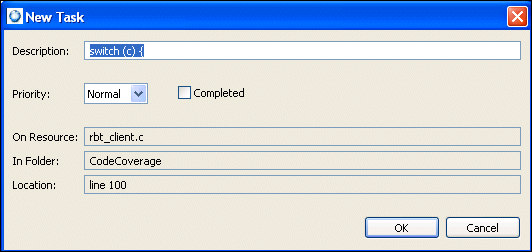
The Outline view provides you with a structural view of your C/C++ source code:
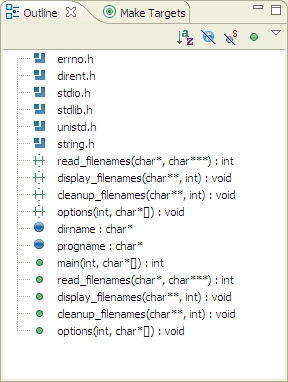
The Outline view shows the structural view of your source
The view shows the elements in the source file in the order they occur, including functions, libraries, and variables. You may also sort the list alphabetically, or hide certain items (fields, static members, and nonpublic members).
If you click an entry in the Outline view, the editor's cursor moves to the start of the item selected.
| Icon | Description |
|---|---|
| Hide Fields | |
| Hide Static Members | |
| Hide Non-Public Members | |
| Sort items alphabetically |
| Icon | Description |
|---|---|
| Class | |
| Namespace | |
| Macro Definition | |
| Enum | |
| Enumerator | |
| Variable | |
| Field private | |
| Field protected | |
| Field public | |
| Include | |
| Method private | |
| Method protected | |
| Method public | |
| Struct | |
| Type definition | |
| Union | |
| Function |
You can filter the Outline view by choosing to display or hide various items, such as fields, static members, and non-public members. You can select an element in the Outline view and then:
Use working sets to group elements to display in the Outline view, or for operations on a set of elements. When using the search facility, you can also use working sets to restrict the set of elements that are searched.
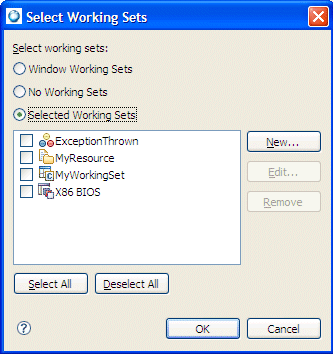
The Working Sets dialog for selecting elements to display in the Outline view.
If you click New to create a new working set, you can choose from these different types: QNX Sources, C/C++, a Breakpoint, and a Resource working set.
The Console view shows the output from the make utility:
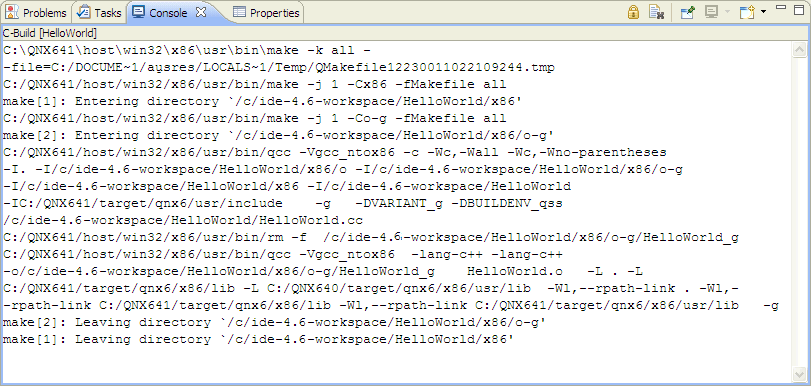
The Console view shows the output from make.
You can choose to clear the Console view before each new build or let the output of each subsequent build grow in the display. Whenever you perform a build, you can also have the Console view appear on top of the other stacked views.
To set the preferences for the Console view:
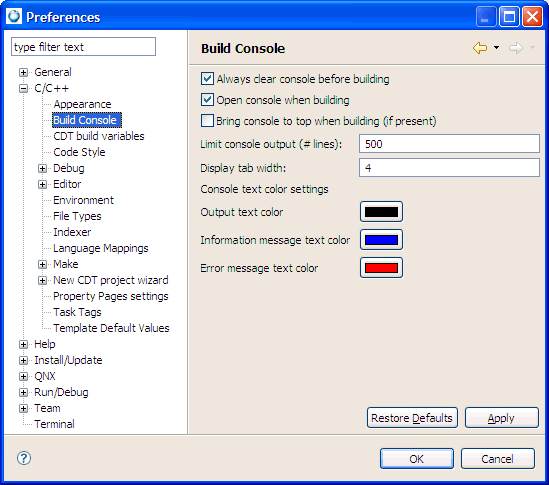
The C Build Console preferences.
While editing source code in the editor, you can select a function name and press F3, and the editor immediately jumps to the prototype for that function (if the file is also in your project).
Press Ctrl-F3, and the editor immediately jumps to the function's implementation (if the file is also in your project).
 |
For more information about the C/C++ perspective, see the link in the Workbench User Guide and the C/C++ Development User Guide. |
To open a header file, right-click the file's name in the Outline view (for example stdio.h), and then choose Open.
Many of the enhanced source navigation (including opening header files) and code development accelerators available in the C/C++ editor are extracted from the source code. To enable these features and provide the most accurate data representation, you must properly configure the project with the include paths and define directives used to compile the source.
For QNX projects, the include paths and definitions are set automatically based on the compiler and architecture. You can set additional values in the project's properties.
For C/C++ Make projects, you must define the values yourself, either manually using the Paths and Symbols tab of the project's properties, or automatically using the Set QNX Build Environment… item in the project's context menu.
To set the include paths and define directives for a C/C++ Make project:
The Paths and Symbols panel appears:
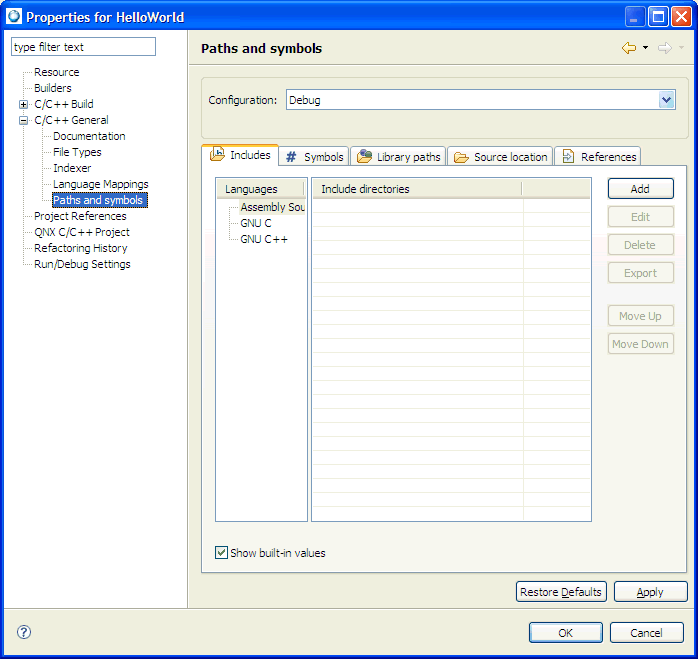
The Go To Type command lets you jump directly to a specific type. Navigating by type provides direct navigation to the following: namespace, typedef, class, enum, struct, and union.
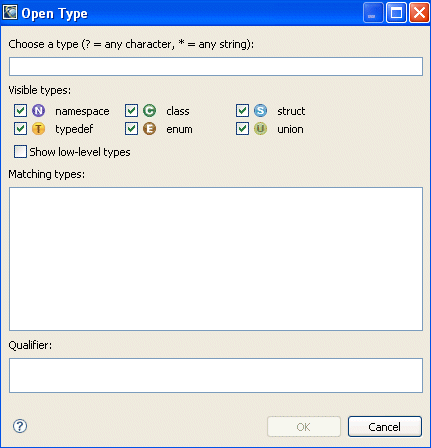
Navigating using the Go To Type command.
![[Previous]](prev.gif) |
![[Contents]](contents.gif) |
![[Index]](keyword_index.gif) |
![[Next]](next.gif) |